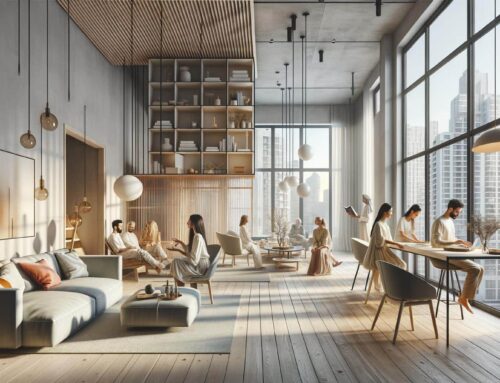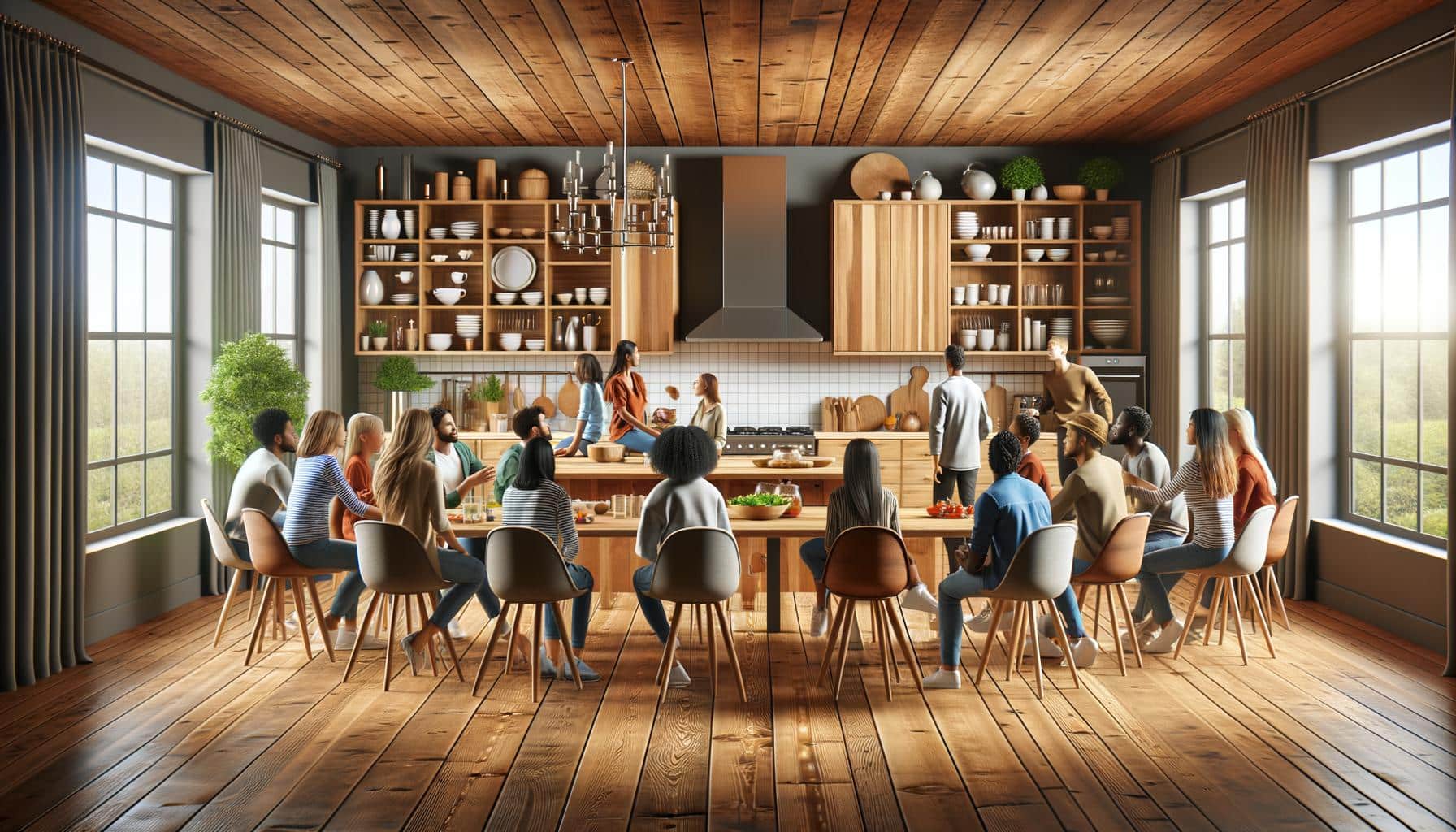
Kitchen renovations can increase your home’s value by up to 20%, with timber being one of the most popular choices among homeowners today.
We at Home Owners Association see timber kitchen renovation ideas gaining momentum as more families seek natural materials that combine beauty with functionality. The right timber selection transforms ordinary kitchens into stunning spaces that last decades.
Which Timber Types Work Best for Kitchen Renovations
Hardwood Options That Stand the Test of Time
American white oak dominates kitchen renovations for cabinetry. This timber resists daily kitchen wear while its light, contemporary appearance brightens any space. Cedar costs $60-100 per square metre and provides natural moisture resistance that works perfectly near sinks and dishwashers. Tasmanian oak delivers versatility at $70-110 per square metre, adapts from traditional farmhouse designs to sleek modern aesthetics with ease.
Engineered Solutions That Cut Costs Without Compromise
Engineered timber cuts renovation costs by 30-40% compared to solid hardwood while it maintains visual appeal. Timber veneer over MDF substrate costs $40-70 per square metre and eliminates concerns about wood movement in humid kitchen environments. Pre-finished timber veneers save installation time and labour costs (a significant advantage for busy households). Quarter-cut veneers produce consistent grain patterns that create professional results across large cabinet runs.
Sustainable Choices That Boost Property Value
Forest Stewardship Council certified timber adds market value while it supports responsible forestry practices. Reclaimed timber from demolished buildings costs $50-90 per square metre and provides unique character that new timber cannot match. Queensland maple from sustainable plantations offers elegant grain patterns at competitive prices of $65-95 per square metre. These eco-friendly choices appeal to environmentally conscious buyers and can increase resale value by up to 8% (according to recent property market data).
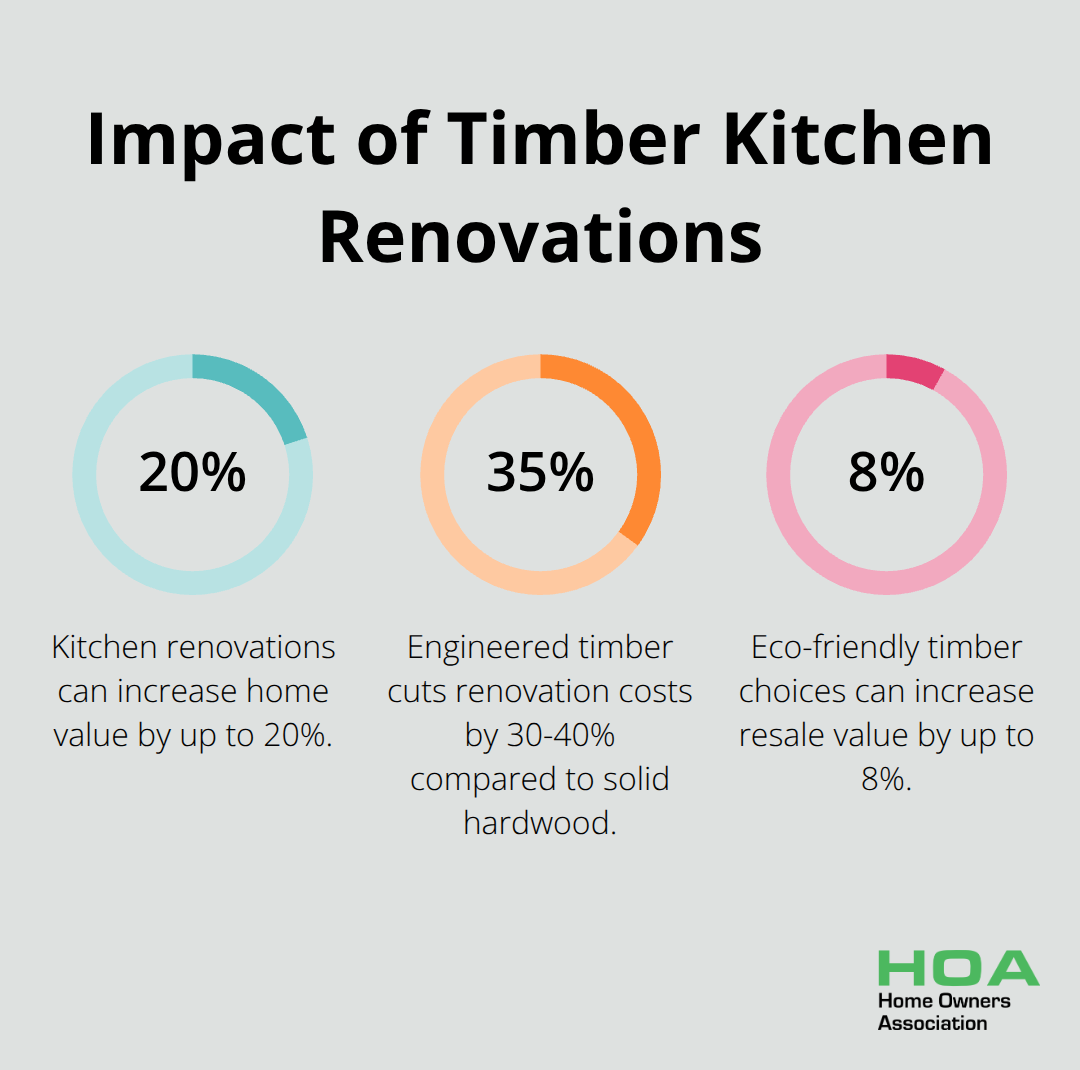
Once you select your timber type, the next step involves careful budget planning and timeline management to turn your vision into reality.
How Do You Plan a Successful Timber Kitchen Renovation
Timber kitchen renovations require $22,000-45,000 for average-sized projects, with 60% allocated to materials and 40% to labour costs. Set aside an additional 20% for unexpected issues like structural modifications or plumbing relocations that surface during demolition. Australian renovation timelines span 6-10 weeks for complete timber kitchen transformations, with cabinet manufacturing consuming 3-4 weeks alone.
Budget Allocation and Timeline Management
Book contractors 8-12 weeks in advance during peak renovation seasons from March to November when demand peaks across major cities. Quality timber cabinetry constitutes 30-50% of your total budget, making it the largest single expense in most projects. Labour costs fluctuate based on complexity (simple cabinet swaps cost less than full structural changes that require wall removal or electrical upgrades).
Climate Considerations Drive Timber Selection
Humid coastal areas demand moisture-resistant species like cedar or treated hardwoods that withstand 70-80% humidity levels without warping. Dry inland regions suit traditional hardwoods like American white oak or Tasmanian oak that perform excellently in low-humidity environments below 50%. Northern Australian kitchens experience temperature swings that create expansion and contraction cycles, making sustainable materials like engineered timber the superior choice over solid timber that can fail at joints.
Contractor Selection and Permit Requirements
Licensed kitchen renovators charge $80-120 per hour compared to handymen at $40-60 who lack specialised joinery skills for precision timber installation. Council permits cost $300-800 for structural changes but exemptions apply for like-for-like cabinet replacements without electrical or plumbing modifications. Qualified electricians must handle any new power points or circuits, with costs ranging $150-250 per additional outlet (plumbing permits become mandatory when relocating sinks or dishwashers beyond 1.5 metres from existing connections).
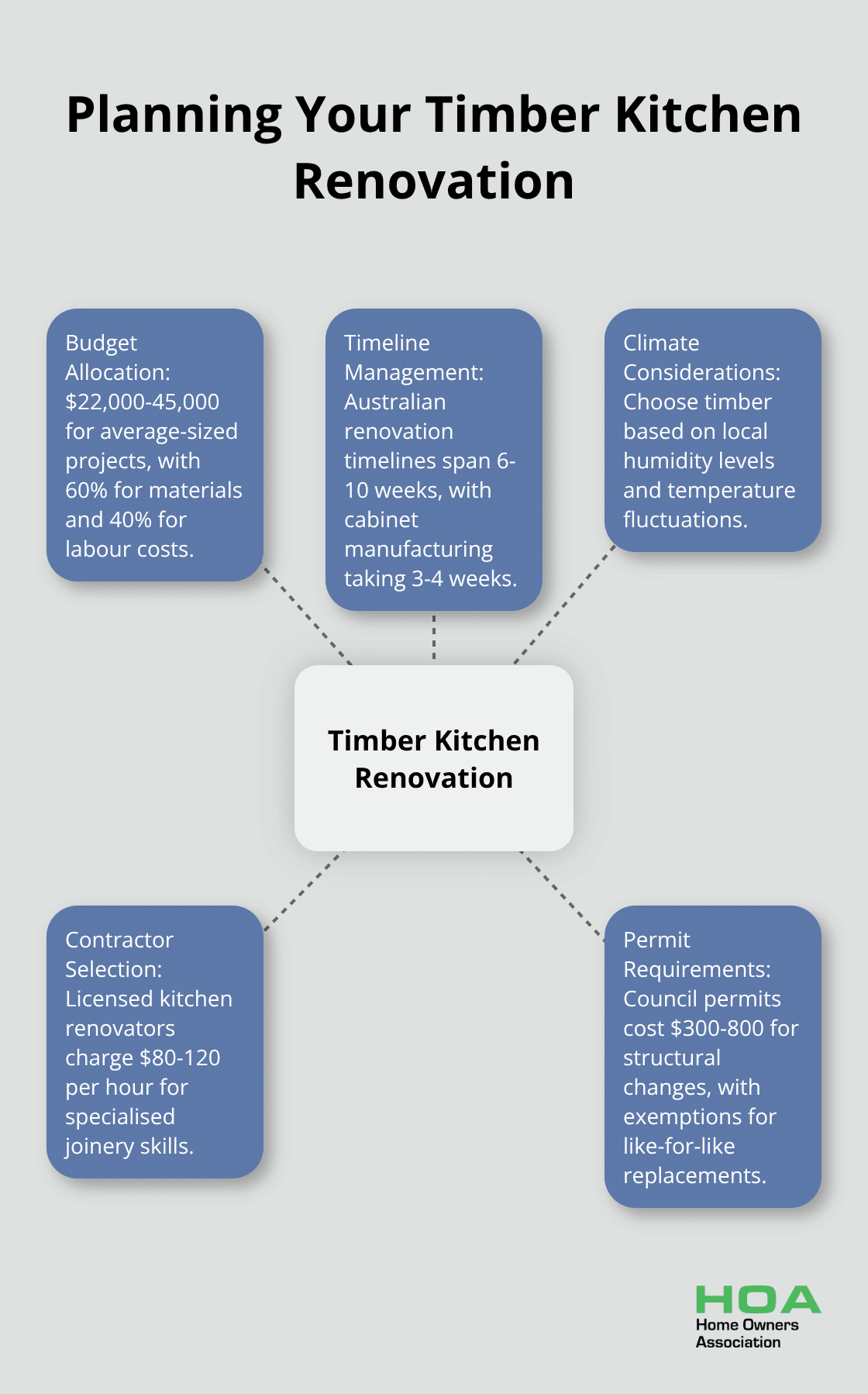
Once you secure permits and contractors, proper installation techniques become the foundation for a timber kitchen that maintains its beauty for decades. Calculating your renovation costs accurately ensures your project stays within budget while achieving the desired transformation.
How Do You Install and Maintain Timber Kitchens Properly
Professional installers allow timber materials to acclimatise for 72 hours in the installation environment before they mount cabinets. Temperature fluctuations during installation cause early timber failures, which makes controlled environments mandatory. Install timber cabinets at 18-22°C with humidity levels between 45-55% to prevent warping and joint separation.
Installation Techniques That Prevent Common Failures
Pre-drill all screw holes 2mm smaller than fastener diameter to prevent timber splitting. Use stainless steel hardware exclusively to avoid rust stains that permanently damage timber surfaces. Cabinet hardware installation requires 12mm expansion gaps behind wall-mounted units to accommodate seasonal timber movement. Mount heavy stone benchtops with proper support brackets every 600mm to prevent cabinet frame stress that leads to door misalignment.
Daily Care Methods That Preserve Natural Beauty
Clean timber surfaces daily with pH-neutral cleaners mixed at 1:10 ratios with warm water to remove grease without damage to natural wood oils. Microfibre cloths outperform cotton alternatives because they capture particles without scratches to delicate timber finishes. Avoid ammonia-based products that strip protective coatings and cause permanent cloudiness on lacquered surfaces. Wipe spills within 15 minutes to prevent moisture penetration that leads to water rings and permanent stains.
Weekly Deep Maintenance Routines
Apply specialised timber cleaners weekly (costing $12-18 per bottle) to extend finish life by 40% compared to generic household products. Check cabinet door alignment monthly and adjust hinges immediately when gaps appear uneven. Tighten loose drawer slides before they create excessive wear on timber cabinet boxes. Polish timber surfaces with appropriate products every two weeks to maintain protective barriers against kitchen moisture and heat.
Professional Refinishing That Extends Timber Life
Sand timber surfaces with 220-grit paper every 5-7 years to remove surface scratches and prepare for new finish application. Professional refinishing services charge $35-50 per linear metre but restore timber to original condition when performed correctly. When searching for the most durable kitchen cabinet finish, catalysed lacquer consistently ranks at the top. Check cabinet hinges and drawer slides annually because loose hardware accelerates timber wear at stress points where repairs become costly.
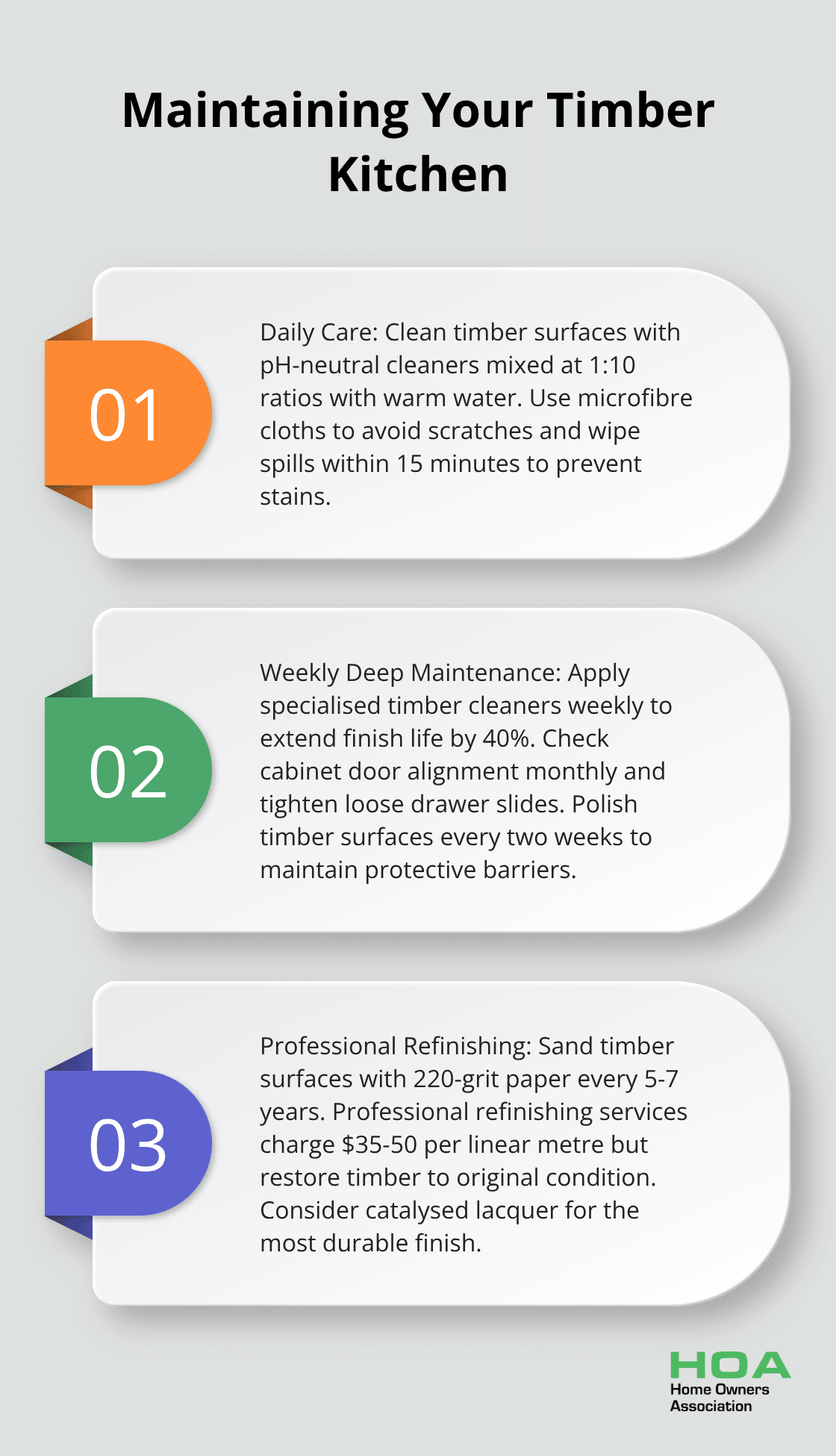
Final Thoughts
Timber kitchen renovation ideas deliver exceptional returns on investment while they create spaces that families love for decades. Smart material selection saves 30-40% compared to premium hardwood options without it sacrifices visual appeal or durability. Professional installation techniques prevent costly failures that plague DIY projects, which makes contractor investment worthwhile for long-term success.
Budget plans with 20% contingency funds eliminate renovation stress when unexpected issues arise during demolition or installation. Climate-appropriate timber choices prevent warping and joint failures that require expensive repairs within five years. Daily maintenance routines with pH-neutral cleaners extend timber life by 40% compared to harsh household products (professional refinishing every 5-7 years maintains original beauty).
We at Home Owners Association connect homeowners with experienced contractors who deliver professional results. Home Owners Association membership provides expert guidance throughout your renovation journey, from initial planning through final installation. Transform your kitchen with confidence knowing you have professional support that makes premium timber renovations achievable for every budget.

